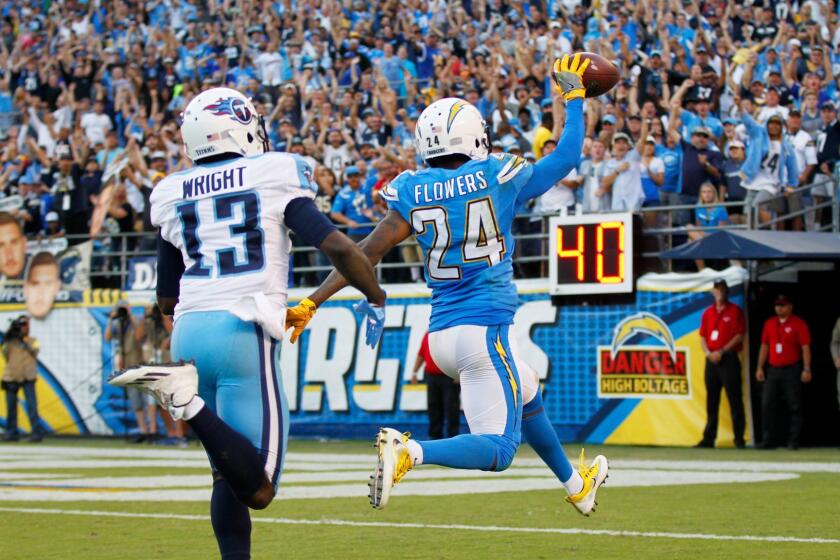Chargers clinical with second chance
The Chargers offense was shown a video recently.
Consider it a lesson by example.
Shane Streichen, a quality control coach, used a clip from a Seattle game to illustrate a point on the two-minute offense. As coach Mike McCoy described it, a Seahawks player tossed the football to the ground after a play while the team was in clock-killing mode. Quarterback Russell Wilson retrieved the ball and lobbed it to an official who dropped it, having to bend down and pick it up before spotting it, all the while valuable seconds passed.
Running back Donald Brown saw this video.
He applied the lesson as intended.
A dramatic 27-24 win Sunday over the Rams will be remembered for a number of singular plays, the last of which was a game-clinching Marcus Gilchrist interception. A key sequence, however, was as critical as any one of them. The Chargers ran a two-minute drill to close the second quarter and showed significant strides in the situation in one week’s time.
Five games, beginning Sunday in Baltimore, remain this regular season with a playoff berth in the balance.
How the Chargers execute their hurry-up offense very well could be the difference in at least one of them.
A week earlier, the team wasn’t proud of its performance.
Wide receiver Keenan Allen caught a pass late in the second quarter against the Raiders. He nearly made it out of bounds but didn’t quite. Confusion followed as seconds passed, and the team ultimately let the clock run down before calling its final timeout. Nick Novak would miss a 48-yard field goal, although that result is irrelevant as this topic is concerned.
Those few seconds after Allen’s catch were wasted.
In the days that followed, they were used.
“We learned from the one last week,” McCoy said. “There’s no way we shouldn’t have clocked that ball when Keenan was declared down. That should be a no-brainer. But we didn’t because not everyone had that same sense of urgency. You learn something from every week. That’s a great example of how poorly we executed the week before, and then we come back the next week and execute to perfection.”
It was clinical.
The drive against St. Louis begin at the Chargers’ own 17-yard line with a timeout and 1:33 remaining before halftime.
After quarterback Philip Rivers opened with a 4-yard pass to tight end Antonio Gates, he hit wide receiver Eddie Royal for 12 yards on a crossing route. Royal ran out of bounds, the clock at 1:10. Rivers didn’t force anything, taking what was there. He threw away a deep pass before a five-man rush could arrive and found Royal the next for 11 yards, the slot receiver turning upfield for a first down when sensing he wouldn’t be able to reach the sideline again.
Brown caught a pass the next two plays for a combined 20 yards.
On his second reception, he gave himself up and dove to the ground, not fighting for extra, time-consuming yards. After both receptions, he stood up and, rather than toss the football to the ground or to an official, jogged over and handed it to him. It was the moral to the Seattle story.
“It helps,” Brown said of the video. “You just have to be mindful. Your attention to detail has to be on point, end of discussion. There’s no other way around it. ... Sometimes, you’ll make a mistake. The key is to learn from the mistake and keep moving forward. I’ve been in countless two-minute situations before, but you also see around the league, guys make mistakes. You learn from other people’s mistakes sometimes, too.”
The Chargers wound up attempting, for the second straight, a 48-yard field goal before half.
Like the offense before him, Novak executed. It was the difference in the game.


